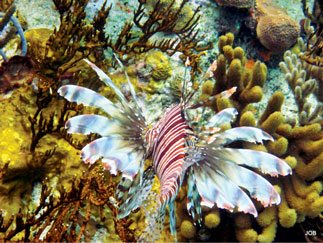
One of the joys of cruising in the Caribbean is taking a swim off the boat to get some exercise, watch fish and look at coral. Some areas are filled with life and others seem dead, so what’s the deal?
The chances are good that the places with the most fish, coral and sponges are marine protected areas. In this article I will use the general term of marine protected area (MPA) to cover a wide variety of areas that include marine reserves, marine management areas and National Parks. There are over 100 MPAs in the Eastern Caribbean and they range in size from a few square meters to hundreds of hectares.
The impetus to protect marine areas is often the recognition of declining fisheries that are unbalanced in size and age structure, deteriorating coral reefs, degradation of water quality due to terrestrial runoff and the loss of potential of tourist income.

Setting up an MPA is challenging. Ideally all of the stakeholders are involved in the conceptual development and the regulations of the area. The planning process for protecting marine areas is complicated by conflicting uses of the marine resources. The protection offered in MPAs differs; some prohibit any resource extraction, while others have areas zoned for specific uses such as fishing or collection of conch, or activities to provide for tourism. These uses can conflict.
Scientists monitor the protected areas and non-protected areas to detect the benefits of protection. The results of monitoring have been a mixed bag. In some MPAs studies have shown that fish populations increase, the fish grow larger, produce more young and the entire marine ecosystem reaches greater abundance and diversity. The robust fish populations thrive in the protected areas and move out into other parts of the ocean and replenish weaker populations. This is called ‘Spillover’ and the larger the protected area, the greater the spillover effect. Within five years of creation of the Soufrière Marine Management Area (SMMA) in St. Lucia, fisherman within and outside the SMMA saw their catch increase between 46 and 90%, depending on the type of gear used. The health of branching coral also improved. The more robust ecosystem is also more resistant to natural disasters like hurricanes. Not all MPAs can report improved ecosystem health and this is probably due to outside stressors such as rising sea temperatures and ocean acidity, terrestrial runoff and pollution. Invasive species such as lionfish are a serious threat to the reef ecosystem. Most areas do not have adequate staff to enforce the regulations and monitor the area. Tourism can provide local economies a boost, but if not managed it can also have a negative effect on the protected area.

I would love, in this short article, to tell you that marine reserves work so well that they are the solution to declining global marine fisheries. Globally, just 2.8% of the oceans are protected by some sort of MPA, and less than half of this protected ocean area is closed completely to fishing. The pitfalls are many. Some protected areas are too small to provide adequate protection of habitat for fish and other resources. Natural disasters can be devastating. The record 2017 hurricane season has had a huge impact upon the marine ecosystems in the Eastern Caribbean and will provide the opportunity to monitor post hurricane impacts on MPAs
Protected areas that stand out in my mind are the Cousteau Reserve at Pigeon Island in Guadeloupe, the SMMA in St. Lucia, US Virgin Islands National Park in St. John, Scotts Head area in Dominica, and the Tobago Cays in St. Vincent and the Grenadines. Two new areas are worthy of note. In August 2014 the islands of Antigua and Barbuda took a bold step in marine conservation by establishing five marine sanctuaries, collectively protecting 33% of the coastal area of Barbuda.
Saint Kitts and Nevis has zoned all of the coastal areas within a two mile radius around both islands for some level of protection.
Visit the areas and pay the fees when appropriate, greet the rangers respectfully and thank them for protecting the resources, use your holding tank and do not discharge sewage in sensitive areas, enjoy yourself and follow the rules. Do not touch or remove coral.
Devi Sharp is a retired wildlife biologist who spent eight years cruising the Caribbean with her husband, Hunter, on their sailboat, Arctic Tern. Devi and Hunter are now living on dirt in Western North Carolina.
Jane Baum and her husband Dick have lived aboard their sailboat Cheetah 2 since 2002. When they started their ‘five year adventure’ Jane did not know how to swim. The water called her and Jane became a scuba diver and underwater photographer.




